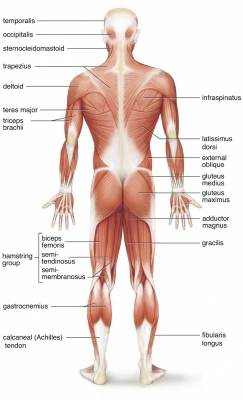
At first glance, muscle names may appear difficult to read, but they have all been given a unique Latin name to describe them. This name can be understood around the world. The chosen name relates to specific characteristics of the muscle, such as its size, shape, location, and what it does.
Occipitofrontalis
This muscle extends over the skull to the eyebrows. Together with temporoparietalis, it comprises the epicranial group of the muscles of facial expression.
Sternocleidomastoid
The sternocleidomastoid muscle is a two-headed neck muscle, which true to its name bears attachments to the manubrium of sternum (sterno-), the clavicle (-cleido-), and the mastoid process of the temporal bone (-mastoid). This turns the head.
Right trapezius
The trapezius muscle is a large, triangular, paired muscle located on the posterior aspect of the neck and thorax. When viewed together, this pair forms a diamond or trapezoid shape, hence its name. The trapezius lies on top of the other back muscles.
Left trapezius
Although each of the two trapezius muscles is triangular, together they make a four-sided shape called a trapezium.
Deltoid
The deltoid is a thick, triangular shoulder muscle. It gets its name because of its similar shape to the Greek letter ‘delta’ (?). The muscle has a wide origin spanning the clavicle, acromion and spine of scapula. This muscle lifts the shoulder and upper arm.
Teres major
The teres major is a thick muscle of the shoulder joint. It spans from the inferior aspect of the scapula to the proximal part of the humeral shaft. This muscle pulls the arm towards the body and turns it inwards.
Triceps brachii
Triceps brachii is a three-headed (tri – three, cep – head) muscle of the arm. It represents the only constituent of the posterior muscle group of the arm, spanning almost the entire length of the humerus. The triceps brachii muscle consists of a long, medial and lateral head, that originate from their respective attachments on the humerus and scapula, and insert via a common tendon on the ulna.
Triceps brachii tendon
This is where the fleshy parts of the three-headed triceps brachii muscle meet.
Latissimus dorsi
The latissimus dorsi muscle is the widest muscle in the human body. It is relatively thin and covers almost all back muscles at the posterior trunk, except the trapezius. This is a large, flat muscle, which helps to pull the arm into the body and turn it inwards.
Transversus abdominis
The transversus abdominis is a broad paired muscular sheet found on the lateral sides of the abdominal wall. Along with the external abdominal oblique and the internal abdominal oblique, it comprises the lateral abdominal muscles. This muscle provides stability for the pelvis.
Gluteus maximus
The gluteus maximus is the most superficial gluteal muscle that forms the prominence of the gluteal region. Along with the gluteus medius, gluteus minimus and tensor fasciae latae, it belongs to the gluteal group of the hip muscles. This large muscle helps to move the hip and thigh.
Adductor magnus
The adductor magnus muscle is a large triangular muscle of the lower limb, with its apex situated on the hip bone, and its base on the linea aspera of the femur. It is situated both in the posterior and medial fascial compartments of the thigh. The distribution of this muscle in two compartments is reflected in the fact that it receives dual nerve supply. Regardless of its position, the adductor magnus muscle is classified as a muscle of the medial compartment of the thigh.
Gracilis
Gracilis muscle is a long and slender muscle located in the medial (adductor) compartment of the thigh. It forms part of the adductor muscle group together with adductor longus, adductor brevis, adductor magnus and pectineus muscles.
Biceps femoris
Biceps femoris is a long muscle of the posterior aspect of the thigh. Together with the semitendinosus and semimembranosus muscles, it makes the group of muscles commonly known as the hamstrings.
Semitendinosus
Semitendinosus is a fusiform muscle of the posterior compartment of thigh. Along with semimembranosus and long head of biceps femoris it comprises a group called the hamstring muscles.
Gastrocnemius
Gastrocnemius is a large muscle located in the posterior leg. Posteriorly, is the most superficial of the muscles of the leg, and forms the bulk of the calf.
Soleus
The soleus muscle is a wide flat leg muscle found on the posterior leg. It runs from just below the knee to the heel and lays immediately deep to the gastrocnemius. These two muscles, along with the plantaris muscle, belong to the group of superficial posterior compartment calf muscles. Together with the gastrocnemius, this strong muscle forms what is known as the calf muscle.
Picture Credit : Google

